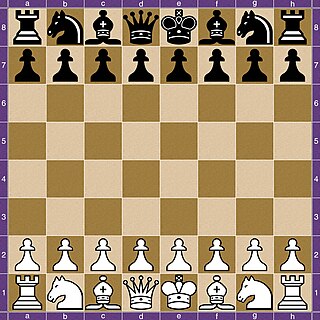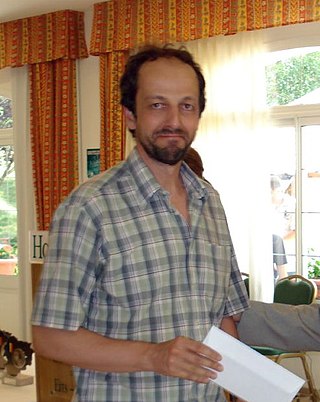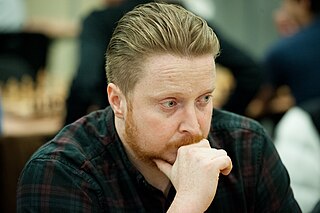Zugzwang is a situation found in chess and other turn-based games wherein one player is put at a disadvantage because of their obligation to make a move; a player is said to be "in zugzwang" when any legal move will worsen their position.
The Lucena position is one of the most famous and important positions in chess endgame theory, where one side has a rook and a pawn and the defender has a rook. Karsten Müller said that it may be the most important position in endgame theory. It is fundamental in the rook and pawn versus rook endgame. If the side with the pawn can reach this type of position, they can forcibly win the game. Most rook and pawn versus rook endgames reach either the Lucena position or the Philidor position if played accurately. The side with the pawn will try to reach the Lucena position to win; the other side will try to reach the Philidor position to draw.

John Denis Martin Nunn is an English chess grandmaster, a three-time world champion in chess problem solving, a chess writer and publisher, and a mathematician. He is one of England's strongest chess players and was formerly in the world's top ten.
The middlegame is the portion of a chess game between the opening and the endgame. It is generally considered to begin when each player has completed the development of all or most of their pieces and brought their king to relative safety, and it is generally considered to end when only a few pieces remain on the board. However, there is no clear line between the opening and middlegame or between the middlegame and endgame. At master level, the opening analysis may go well into the middlegame; likewise, the middlegame blends into the endgame.

Joseph Gerald Gallagher is a British-born Swiss chess player and writer. He was awarded the title of Grandmaster by FIDE in 1990 and has been the national champion of both Britain and Switzerland.

The Philidor position is a chess endgame involving a drawing technique for the defending side in the rook and pawn versus rook endgame. This technique is known as the third-rank defense due to the positioning of the defending rook. It was analyzed by François-André Danican Philidor in 1777. Many rook and pawn versus rook endgames reach either the drawn Philidor position or the winning Lucena position. The defending side should try to reach the Philidor position; the attacking side should try to reach the Lucena position. Said grandmaster Jesús de la Villa, "[The Lucena and Philidor positions] are the most important positions in this type of endgame [...] and in endgame theory."

The Tarrasch rule is a general principle that applies in the majority of chess middlegames and endgames. Siegbert Tarrasch (1862–1934) stated the "rule" that rooks should be placed behind passed pawns – either the player's or the opponent's. The idea behind the guideline is that (1) if a player's rook is behind his passed pawn, the rook protects it as it advances, and (2) if it is behind an opponent's passed pawn, the pawn cannot advance unless it is protected along its way.

Karsten Müller is a German chess Grandmaster and author. He earned the Grandmaster title in 1998 and a PhD in mathematics in 2002 at the University of Hamburg. He had placed third in the 1996 German championship and second in the 1997 German championship.

John Michael Emms is an English chess Grandmaster and chess author. He tied for first in the 1997 British Championship. He was the 2002 captain of the English Olympiad team. In October 2004, he also coached a woman's team in the 36th Chess Olympiad in Calvià, Majorca.
In chess, a fortress is an endgame drawing technique in which the side behind in material sets up a zone of protection that the opponent cannot penetrate. This might involve keeping the enemy king out of one's position, or a zone the enemy cannot force one out of. An elementary fortress is a theoretically drawn position with reduced material in which a passive defense will maintain the draw.

Edmar John Mednis was a Latvian-American chess player and writer of Latvian origin. He was awarded the title of Grandmaster by FIDE in 1980.
Much literature about chess endgames has been produced in the form of books and magazines. A bibliography of endgame books is below.

The game of chess is commonly divided into three phases: the opening, middlegame, and endgame. There is a large body of theory regarding how the game should be played in each of these phases, especially the opening and endgame. Those who write about chess theory, who are often also eminent players, are referred to as "theorists" or "theoreticians".
In a chess endgame of a king, bishop, and pawn versus king, a wrong rook pawn is a rook pawn whose promotion square is the opposite color from the bishop's square color. Since a side's rook pawns promote on opposite-colored squares, one of them may be the "wrong rook pawn". This situation is also known as having the wrong-colored bishop or wrong bishop. In many cases, the wrong rook pawn will only draw, when any other pawn would win. This is because the defending side can sometimes get their king to the corner in front of the pawn, after which the attacking side cannot chase the king away to enable promotion. A fairly common defensive tactic is to reach one of these drawn endgames, often through a sacrifice.

The Réti endgame study is a chess endgame study by Richard Réti. It was published in 1921 in Kagans Neueste Schachnachrichten. It demonstrates how a king can make multiple threats and how it can take more than one path to a given location, using the same number of moves. It is covered in many books on the endgame. The procedure is known as the "Réti Maneuver" or "Réti's Idea". Endgame composer Abram Gurvich called the theme "The Hunt of Two Hares" and it appears in many other studies and games. It is also called "chasing two birds at once".

Anthony Cornelis Kosten is an English-French chess Grandmaster and chess author.

Simon Kim Williams is an English chess grandmaster and author who is best known under the pseudonym and Chess Server Nickname "GingerGM".